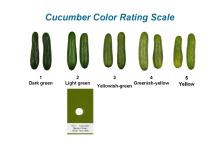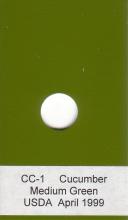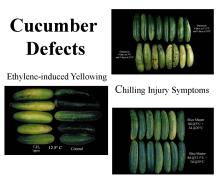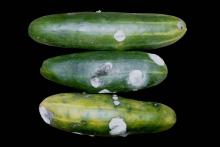Product Description
Índices de madurez
Cucumbers are harvested at a range of developmental stages. Depending on cultivar and temperature, the time from flowering to harvest may be 55 to 60 days. Generally fruit are harvested at a slightly immature stage, near full size but before seeds fully enlarge and harden. Firmness and external glossiness are also indicators of a pre-maturity condition. At proper harvest maturity, a jellylike material has begun to form in the seed cavity.
Table or slicing cucumber quality is primarily based on uniform shape, firmness and a dark green skin color. Additional quality indices are size, freedom from growth or handling defects, freedom from decay, and an absence of yellowing.
U.S. grades are Fancy, Extra 1, No. 1, No. 1 Small, No. 1 Large and No. 2.
Industry grades and specifications follow the packing conventions SuperSelect, Select, Small Super, Small, Large, and Plain. These terms have no enforceable contractual value.
Manejo y almacenamiento poscosecha
10-12.5°C (50-55°F)
Storage of cucumber is generally less than 14 days as visual and sensory quality deteriorate rapidly. Shriveling, yellowing, and decay are likely to increase following storage beyond two weeks, especially after removal to typical retail conditions. Short term storage or transit temperatures below this range (such as 7.2°C (45°F)) are commonly used but will result in chilling injury after 2-3 days.
Chilling Injury. Cucumbers are chilling sensitive at temperatures below 10°C (50°F) if held for more than a day to 3 days depending on temperature and cultivar. Consequences of chilling injury are water-soaked areas, pitting and accelerated decay. Chilling injury is cumulative and may be initiated in the field prior to harvest. Cucumber varieties vary considerably in their susceptibility to chilling injury.
| Temperature | 10°C (50°F) | 15°C (59°F) | 20°C (68°F) | 25°C (77°F) |
| ml CO2/kg·hr | 12-15 | 12-17 | 7-24 | 10-26 |
To calculate heat production, multiply ml CO2/kg·hr by 440 to get BTU/ton/day or by 122 to get kcal/metric ton/day.
Respiration varies widely above 10°C due to different stages of maturity. Less mature cucumbers have higher respiration rates.
Cucumbers are highly sensitive to exogenous ethylene. Accelerated yellowing and decay will result from low levels (1-5 ppm) of ethylene during distribution and short-term storage. Do not mix commodities such as bananas, melons and tomatoes with cucumber.
95%
0.1-1.0 µl/kg·hr at 20°C (68°F)
Controlled or modified atmosphere storage or shipping offer moderate to little benefit to cucumber quality maintenance. Low O2 levels (3-5%) delay yellowing and the onset of decay by a few days. Cucumber tolerates elevated CO2 up (CA) to 10% but storage life is not extended beyond the benefit of reduced levels of O2.
Temperature & Controlled Atmosphere Photos
Desórdenes
See Chilling Injury.
Freezing Injury. Freezing injury will be initiated at -0.5°C (31°F). Symptoms of freezing injury include a watersoaked pulp becoming brown and gelatinous in appearance over time.
Harvesting should be done by cutting free of the vine rather than by tearing. "Pulled end" is a quality defect used in establishing grade quality.
Bruising and compression injury are very common when attention to careful harvest and handling practices are not followed.
Diseases are an important source of postharvest loss, particularly in combination with chilling stress. A large list of bacterial and fungal pathogens cause postharvest losses in transit, storage, and to the consumer. Alternaria spp., Didymella Black Rot, Pythium Cottony Leak, and Rhizopus Soft Rot are common disorders.
Special Considerations
Cucumbers are often treated with approved waxes or oils to reduce water loss, reduce abrasion injury and enhance appearance.
Yellowing during the postharvest period is a very common defect. Harvesting fruit at an advanced stage of development, exposure to ethylene, or storage at too high temperature all cause yellowing.










